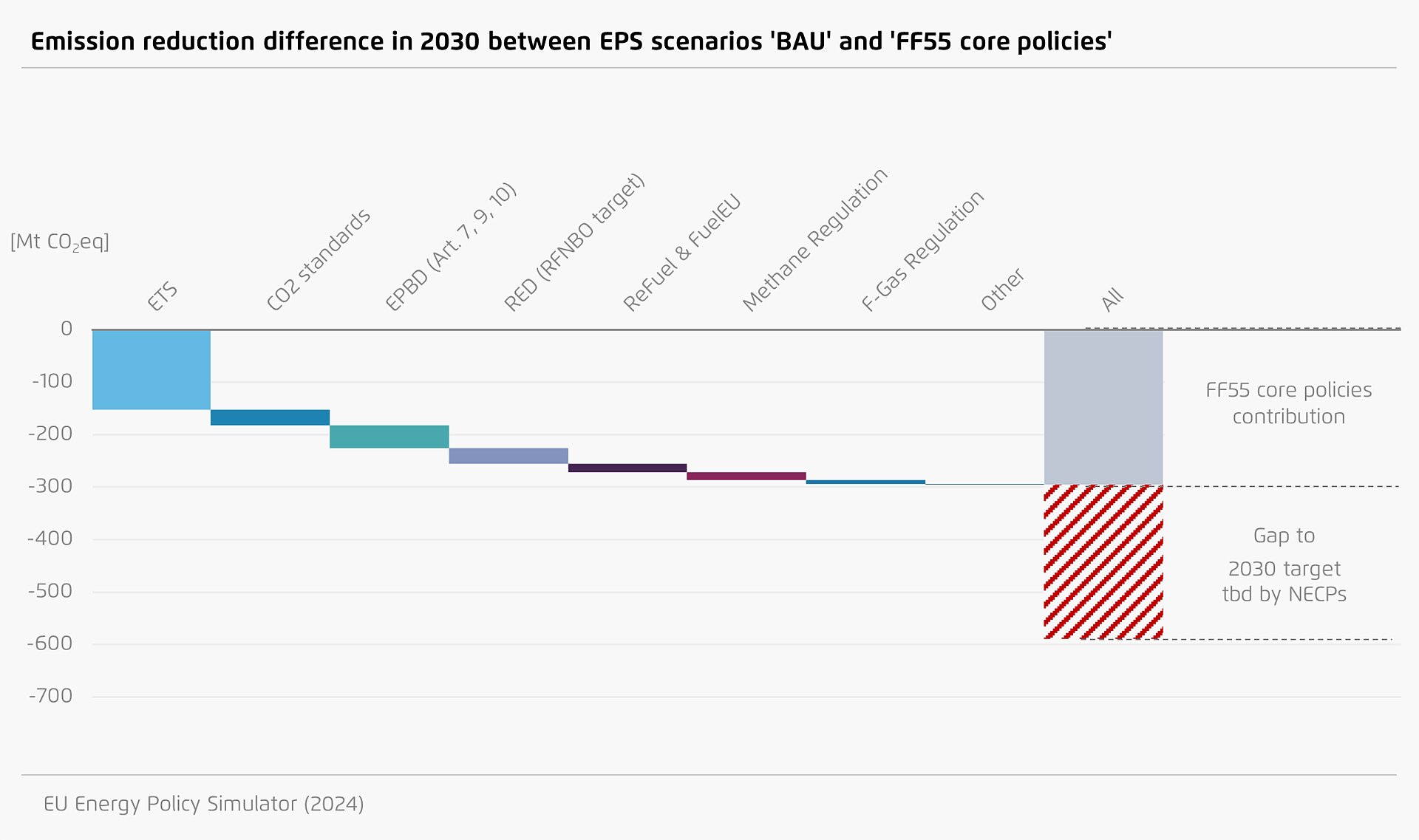Fit for 55 and beyond: how a new online tool can support Europe’s journey to climate neutrality
Implementing the EU’s Fit for 55 package brings significant benefits such as new jobs, clean energy and better air quality. To reach its emission reduction targets, however, the bloc needs additional measures. The new EU Energy Policy Simulator, developed by Agora Energiewende and Energy Innovation, can help policymakers close this ‘delivery gap’.

With the European Green Deal and the Fit for 55 package, the EU has significantly raised its climate ambition. Most notably, they set legally binding targets to reach climate neutrality at the latest by 2050 and to reduce greenhouse gas (GHG) emissions by 55 percent from 1990 levels by 2030. With this overall package adopted, it is now up to the EU and its member states to ensure effective implementation and deliver on these goals.
As the new Commission begins its work, we reflect on the progress made so far and identify key measures to align Europe’s policy response with the targets set under the EU Green Deal. For this, we use the new ‘EU Energy Policy Simulator’ (EU EPS), a free online tool developed by Agora Energiewende and Energy Innovation.
Designed to support policymakers, the EU EPS enables live analysis of a variety of policy instruments across all sectors on a timeline from 2022 through 2050. It provides insights into their effect in areas as diverse as emissions, job creation, tax revenues, vehicle fleets, travel demand, fuel costs, energy use and trade.
Climate delivery gap
Reports on the EU’s progress towards climate neutrality so far give mixed signals. On the one hand, preliminary data from the European Environment Agency shows that net GHG emissions dropped by eight percent in 2023 – the largest reduction in decades – and are estimated to be 37 percent below 1990 levels. An annual reduction of eight percent would mean overachieving the 55 percent target in 2030. However, given that the drop is partly due to circumstantial factors such as a temporarily reduced energy demand, it is unlikely the reduction will continue at this pace.
Looking at projections of member states confirms that there is a delivery gap. The latest assessment of EU member states’ national energy and climate plans (NECPs) shows that current ambitions will only deliver a 49 percent emission reduction by 2030. This leaves an emission reduction gap of six percentage points.
Policymakers now need to design new instruments or adapt existing legislation to close this gap. However, relying on comprehensive modelling exercises can be time consuming as running times are often very high for each scenario. The fast and intuitive EU EPS allows policymakers to explore and compare different policy options, helping them to design the most appropriate approach for closing the emission reduction gap.
The importance of keeping key policies in place
The new tool can also help to demonstrate the importance and impact of key measures adopted under the new Fit for 55 package legislation and the effects of strengthening or weakening the existing policy framework. To this end, we compared a ‘business as usual’ baseline scenario representing the EU’s climate and energy policies before the EU Green Deal with a ‘Fit for 55 core policies’ scenario, drawing several key conclusions.

First, the core Fit for 55 policy measures alone – excluding additional national measures – reduce emissions by 49 percent by 2030. This result is in line with the Commission’s estimates of what EU-level policy can deliver. This means that the legislation passed in the previous policy cycle can deliver half of the difference between the pre-Green Deal world and the 55 percent target. The other half needs to come from national or additional measures.
Second, the recent revision of the EU’s emissions trading system (ETS) is responsible for half of the total expected emission reductions up until 2030. The 'ETS 1' covers emissions from the power sector, energy-intensive industry, shipping and domestic flights, while the 'ETS 2' will cover buildings and transport starting in 2027. This finding underlines the need to stay committed to these pieces of legislation, ensuring that they deliver on their full potential. The other half of emission reductions are divided across a range of different policy instruments, notably the Energy Performance of Buildings Directive (EPBD), CO2 emission standards for cars, the Renewable Energy Directive (RED), ReFuel and FuelEU, Methane Regulation and F-gas Regulation.
Third, the relative impact of different Fit for 55 policies changes significantly over time. By 2050, CO2 standards for cars will drive the highest reduction of all individual instruments of the Fit for 55 package. This is followed by the ETS 1 revision and ETS 2, ReFuel and FuelEU regulations.
Fourth, the Fit for 55 package delivers significant economic and health benefits compared to the pre-EU Green Deal policy framework. Based on our analysis, these measures will help create up to two million additional jobs, lead to a significant increase in solar PV and onshore and offshore wind generation. In terms of positive health effects, implementing the package would help avoid millions of lost working days and close to 50,000 excess deaths per year by 2030 due to reduced air pollution.
The Fit for 55 package is a major achievement in EU climate and energy policy, providing a strong foundation to meet 2030 targets and set an ambitious 2040 emission reduction goal of 90 percent. It is also important to keep in mind that its impact goes beyond these dates; for example, the CO2 emission standards mostly speed up emission reductions after 2030 and provide the highest reductions of all Fit for 55 policies by 2050.
Any weakening of the agreed-upon polices would have to be compensated with steeper emission cuts elsewhere. Furthermore, as shown by the tool, reaching the targets on Europe’s path to climate neutrality will require additional policy measures, including at the EU level. The EU EPS can help policymakers quickly assess new ideas and pathways, supporting informed, fact-based decisions.
The EU Energy Policy Simulator can be accessed free of charge here. All the underlaying data is transparent and freely accessible here. Assumptions, technical background information on the tool and on the EU version of the model can be found here. For information on the methodology, see below.



